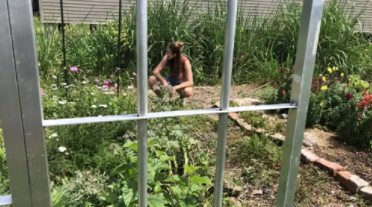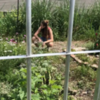In a small patch of green space on Andry Street in New Orleans’ lower ninth ward, nine garden beds lie next to one another, each 6 feet by 9 feet, each the size of one standard solitary-confinement cell. Each garden bed grows a mix of herbs and flowers, among them pansies, stinging nettles, onions, mugwort. They are a mix of plants with medicinal properties and some that just bring pleasure to the eyes, and their growth is limited to the parts of the tiny space where a person would be free to move in a solitary cell, with space blocked off for where the furniture—nothing more than a bed and a toilet—would be. The plants in each garden are chosen by someone in solitary confinement and planted by a volunteer gardener on the outside.
The result is both symbolic and produces plants with tangible uses, says jackie sumell (who does not capitalize her name), who conceived the project; plants with healing properties will be redistributed to people who need them through what sumell calls a “prisoner’s apothecary.” The solitary beds are eventually overrun with plant life, a visual representation of a world without prisons, an idea that forms the project’s core mission.
Typically, a volunteer gardener on the outside will send a list of plants to an incarcerated gardener. The list provides plenty of options but is limited to what will thrive in the climate and season. They collaborate on a gardening plan and a calendar, often with a small floor plan filled in by the incarcerated gardener laying out the positioning of plants.
Once plants get chosen, a plant bed is constructed from tobacco, cotton, and indigo grown on-site, which is mixed with lime, water, and clay, a concoction sumell calls “revolutionary mortar.” Those plants were chosen because of their role in chattel slavery, meant to evoke the connection between the slave trade and the prison system. Then the volunteer plants the incarcerated person’s chosen plants to the best of their ability. Because the beds are only 6 by 9, sometimes not all the plants will fit, and they’ll have to wait until they’ve harvested what they now have.
Many choose plants with healing properties. sumell says one gardener is interested in adaptogens, plants like ginseng and holy basil that are believed to reduce stress levels, and which sumell says can help with internalized trauma. “Their garden was specifically designed thinking about ways that would have prevented getting them in prison to begin with,” sumell says.
To read more of Roshan Abraham's article, please click here.



Comments (0)